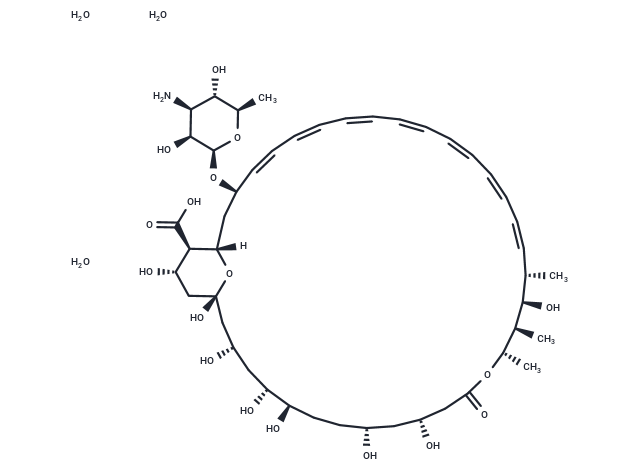Shopping Cart
Remove All Your shopping cart is currently empty
Your shopping cart is currently empty
Amphotericin B trihydrate, a polyene antibiotic derived from Streptomyces nodosus fermenter cultures, exhibits antileishmanial properties.

| Pack Size | Price | USA Warehouse | Global Warehouse | Quantity |
|---|---|---|---|---|
| 25 mg | Inquiry | Inquiry | Inquiry |
| Description | Amphotericin B trihydrate, a polyene antibiotic derived from Streptomyces nodosus fermenter cultures, exhibits antileishmanial properties. |
| In vitro | Amphotericin B, a chemical compound, interacts with cholesterol—primarily found in mammal cell membranes—thus its application is limited due to notable toxicity. In its operational state, Amphotericin B may exist either as a pre-micellar form or in highly aggregated clusters in the subphase. Its antimicrobial mechanism is specific to unicellular Leishmania promastigotes (LPs), where it functions by creating aqueous pores in cell membranes that allow the passage of small cations and anions, leading to cell death. At a concentration of 0.1 mM, Amphotericin B triggers a change in polarization potential indicative of potassium (K+) leakage from KCl-loaded liposomes, a model for cell membranes, in an iso-osmotic sucrose solution. Furthermore, at 0.05 mM, it causes a substantial reduction in the cell's negative membrane potential, suggesting sodium (Na+) influx, a critical factor in cell viability. |
| In vivo | Amphotericin B extends incubation times and diminishes PrPSc accumulation in the hamster scrapie model, while significantly lowering PrPSc levels in mice affected by transmissible subacute spongiform encephalopathies (TSSE)[4]. Additionally, this compound directly targets Plasmodium falciparum, affecting eryptosis in infected erythrocytes, parasitemia, and survival in murine malaria. It also delays the escalation of parasitemia and notably prolongs the survivability of Plasmodium berghei-infected mice[5]. |
| Molecular Weight | 978.136 |
| Formula | C47H79NO20 |
| Cas No. | 1202017-46-6 |
| Smiles | O.O.O.[H][C@]12C[C@@H](O[C@@H]3O[C@H](C)[C@@H](O)[C@H](N)[C@@H]3O)\C=C\C=C\C=C/C=C/C=C/C=C/C=C/[C@H](C)[C@@H](O)[C@@H](C)[C@H](C)OC(=O)C[C@H](O)C[C@H](O)CC[C@@H](O)[C@H](O)C[C@H](O)C[C@](O)(C[C@H](O)[C@H]1C(O)=O)O2 |c:20,t:16,18,22,24,26,28| |
| Storage | Powder: -20°C for 3 years | In solvent: -80°C for 1 year | Shipping with blue ice/Shipping at ambient temperature. |
| Size | Quantity | Unit Price | Amount | Operation |
|---|

Copyright © 2015-2026 TargetMol Chemicals Inc. All Rights Reserved.